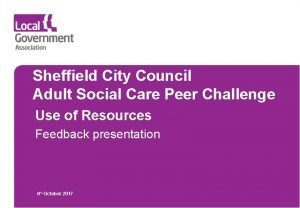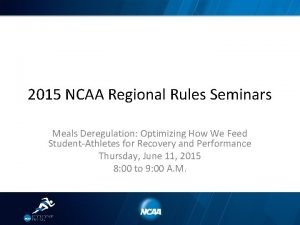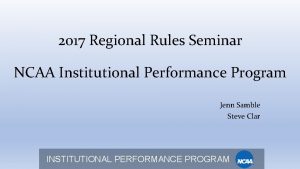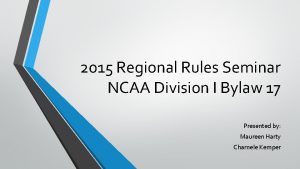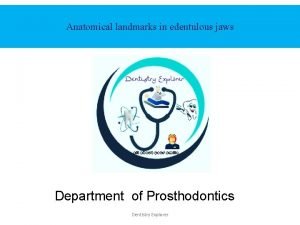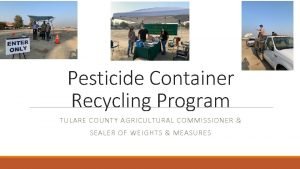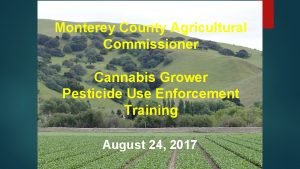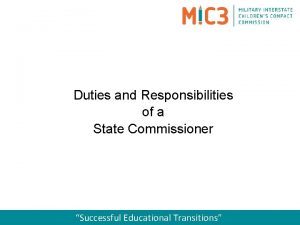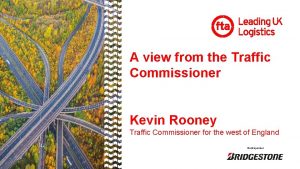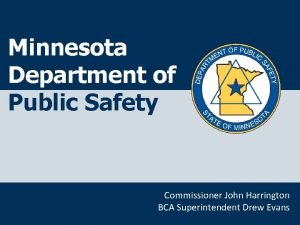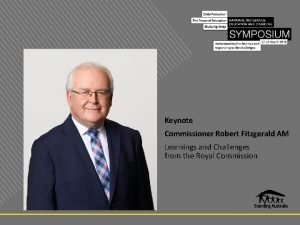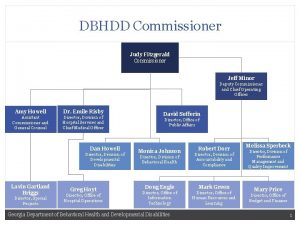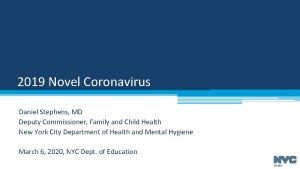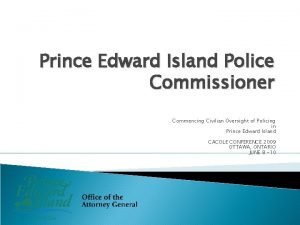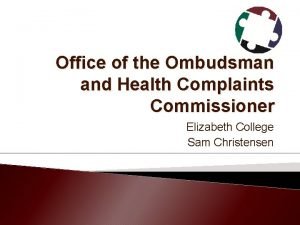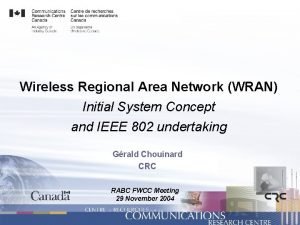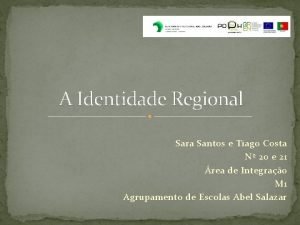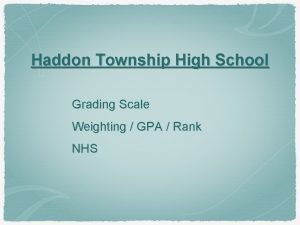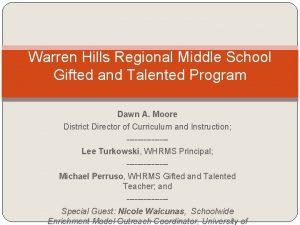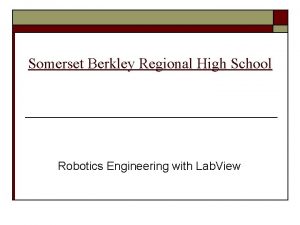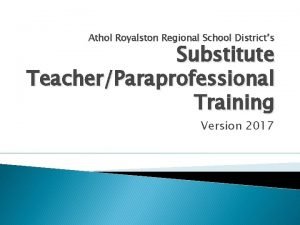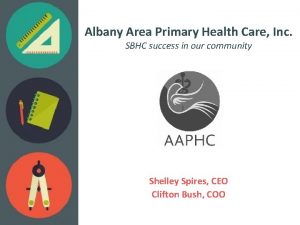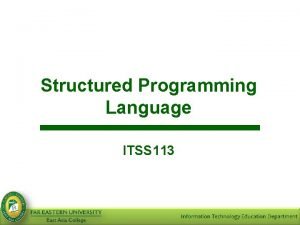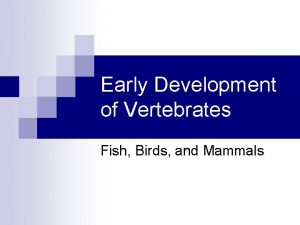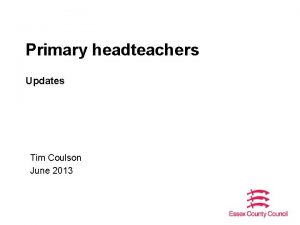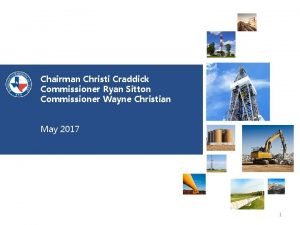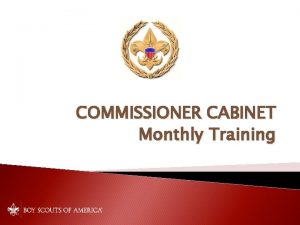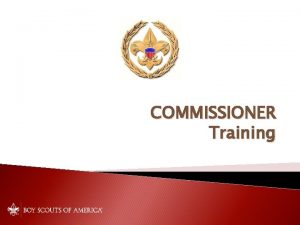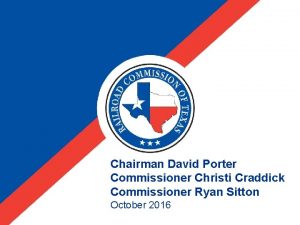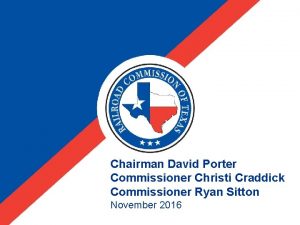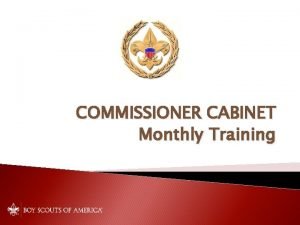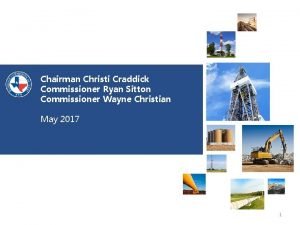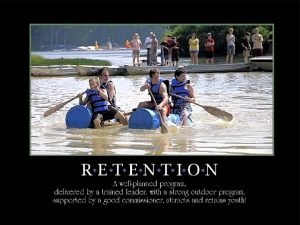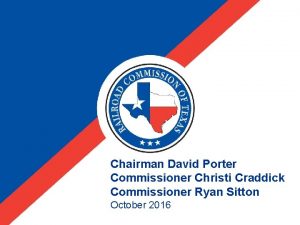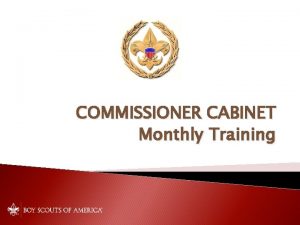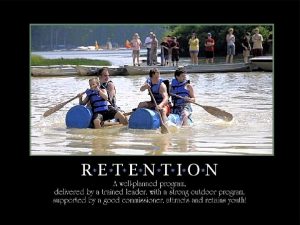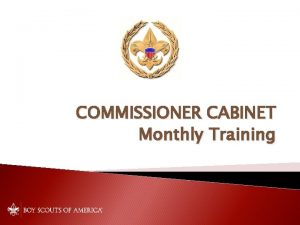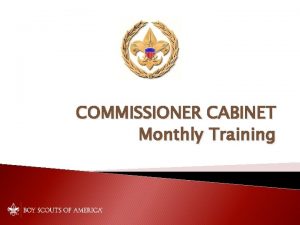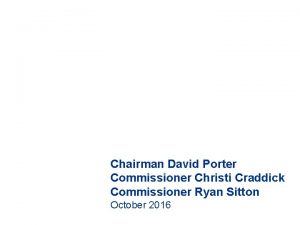Primary Area Seminar Tim Coulson Regional School Commissioner




















































- Slides: 52

Primary Area Seminar Tim Coulson Regional School Commissioner East of England North East London

Outline Update on performance across the region High performing MATs Features of high performing MATs Schools that are not academies - Discussion • Key Stage 2 – meeting the higher standards - Discussion • ‘Schools that work for everyone’ proposals - Discussion • • East of England North East London Region

Miracle in the East • Shift the dialogue from structures to structures that deliver better standards • Expectations are rising in a context of shifting support for the system • Increasing social mobility • As has always been the case, the challenge is one of leadership East of England North East London Region

Why RSCs? The eight Regional Schools Commissioners (RSCs) came into post in September 2014 and report to the National Schools Commissioner (Sir David Carter) RSCs take decisions regarding academies on behalf of the Secretary of State. The Secretary of State remains responsible for the academy system and will hold RSCs to account for the performance of academies in their region. RSCs provide expertise and local knowledge for the management of the academy system: Develop school autonomy. Give system leaders greater influence over the direction of the academies system. Regional decisions, centrally supported – Supported by their Headteacher Boards, RSCs bring decision-making closer to schools by adding greater local/regional knowledge and context. Create an evolving system – allowing flexibility for the system to continue to evolve as the number of academies and free schools grow. East of England North East London Region

East of England NE London East of England North East London Region

Headteacher Board Provides advice and support to RSC decision making. – Approve Academy Conversions – Approve new sponsors – Approve new MATS – Challenge the RSC that interventions are effective & appropriate – Add capacity to RSC office Consists of eight members – 4 elected and 4 Co-opted / appointed. Members are headteachers, CEO’s of MAT’s and others with specific required skillsets. Elected: • Caroline Haynes (Tendring Technology College) • Stephen Munday (CAM Trust) • Debbie Rogan (HEARTS Academy Trust) • Margaret Wilson (The King John School Academy Trust) Appointed: • Dame Rachel De Souza (Inspiration Trust) • Sir Steve Lancashire (Reach 2 Academy Trust) Co-opted: • Mark Jeffries (Mills and Reeve LLP) Have extensive knowledge of the region and a breadth of educational experience. Next elections for the HTB will take place in 2017 and planning is in place for this. East of England North East London Region

Changing role of the RSC • Devolution of functions and responsibilities from the ‘national core’ teams – greater local decision making East of England North East London Region

Overall objectives and. East structure of plan Overall objectives and structure of plan for of England North East London Our ambition is to drive up standards across the region so that every child attends a school or academy whose results are above the national minimum floor standard and is rated as good or outstanding by Ofsted. We will do this by: Building strong sponsors Facilitating collaboration Opening high quality new provision Challenging underperformance • We will balance support with • We will support the government • Collaboration lies at the heart of • There are 141 approved challenge where academies are ambition to open 500 new free the school-led system. We will academy sponsors in our underperforming. schools during this parliament. continue to work proactively with region. We will meet all trusts • We will visit academies to understand • We will encourage existing high schools, academies, LAs, obstacles to improvement before quality trusts to apply to open free of 3 or more schools during the Teaching School Alliances and deciding how to intervene. schools. autumn term. others to share best practice, • We will use local intelligence and • We will identify the areas of • We will use the meetings to support school improvement and relations with trusts to identify low social mobility and basic need in identify those with potential to performance issues early. the region to ensure new provision is the development of leadership • We will use formal intervention in a opened where it is most needed. grow and those who need and pedagogy. small number of cases where • We will work with to encourage non • We will continue to hold events support to improve. academies have underperformed for school based groups such as to get system leaders to meet, • We will use our trust evaluation a period of time or where we are not parents, charities and universities to share knowledge and best tool to identify areas for convinced by trusts improvement open schools. We will also work with practice and form new networks. development and offer support, plans. independent schools and faith • With the Teaching School • When required we will transfer based providers. for example mentoring, CEO Council we will develop a website • HTB members will play an active role academies to other trusts. leadership training. sharing best practice and making • We will ensure that maintained in the interview process for free • We will target Sponsor schools judged inadequate by Ofsted schools. resources available for all to use. Capacity Funding to help become sponsored. • We will work closely with LAs who • We will work with Teaching • We will use our intervention powers open new provision through the develop trusts in priority areas School Alliances and the National where maintained schools are academy presumption process to of the region. College to ensure work focusses underperforming or defined as ensure new provision is run by high on school improvement and that • We will identify more sponsors `coasting’. quality providers. school to school support goes to and encourage outstanding • We will monitor, support and institutions most in need. schools and academies to challenge newly opened free schools to help ensure they are rated Good or support others. Outstanding by Ofsted in their first • We will use Academy inspection. Ambassadors to strengthen • We will help to address common trust governance. N. B. Work strand 2 b sets out our commitment to SESL staff and appropriate internal resourcing. We will not use for national reporting but will link with and national issues with UTCs Studio Schools indicators on expected capacity of staff. 8 around pupil recruitment and funding.

Making sense of the accountability landscape • SATS and MATS are accountable for outcomes in their schools • OFSTED assesses how well schools perform against schools with same context • RSC challenge and support those schools not yet good enough • NCTL provides the pipeline of teachers and leaders and system capacity • Local authorities oversee SEN, admissions, safeguarding, transport and sufficiency of places East of England North East London Region

2016 Phonics outcomes Percentage Meeting Expected Standard Year 1 Standard Year 2 Peterborough Cambridgeshire Norfolk Suffolk Southend on Sea Redbridge Essex Tower Hamlets Barking and Dagenham Haringey Thurrock Waltham Forest Hackney Havering Newham 77 78 78 79 80 80 81 81 81 82 83 83 85 85 87 88 91 91 88 92 92 90 88 92 92 93 94 92 EENEL 81 91 England 81 91 East of England North East London Region

2016 Key Stage 1 outcomes Reading Writing Mathematics Peterborough Suffolk Cambridgeshire Norfolk Barking and Dagenham Thurrock Tower Hamlets Essex Southend on Sea Havering Redbridge Haringey Newham Waltham Forest Hackney 68 72 73 75 75 76 76 77 77 78 79 79 81 61 64 63 70 68 68 70 68 69 70 68 74 75 74 78 69 71 71 74 75 75 75 74 74 77 76 78 79 80 82 EENEL 76 69 75 England 74 65 73 East of England North East London Region

Provisional 2016 Key Stage 2 outcomes Percentage of pupils achieving the expected standard Norfolk 49 Cambridgeshire 49 Essex 55 Suffolk 48 Peterborough 39 Hackney 63 Barking and Dagenham 57 Southend on Sea 55 Thurrock 51 Haringey 49 Newham 59 Tower Hamlets 60 Havering 62 Redbridge 56 Waltham Forest 53 EENEL 53 Average of Reading progress score 0. 02 0 0. 01 -0. 43 -0. 9 1. 63 0. 2 -0. 11 -0. 93 0. 91 1. 45 1. 21 0. 8 0 1. 07 Average of Writing progress score 0. 76 -0. 8 0. 51 -0. 96 0. 63 2. 81 1. 59 0. 84 -0. 12 2. 97 3 2. 02 1. 11 0. 73 2. 76 Average of Maths progress score -1. 18 -0. 72 0. 13 -1. 26 -0. 62 1. 71 1. 7 0. 02 -0. 4 1. 47 2. 7 1. 82 0. 82 1. 15 2. 29 KS 2 below floor 2016 18 16 13 13 5 1 1 0 0 0 0 0. 15 0. 64 0. 00 67 East of England North East London Region

2016 Key Stage 4 Outcomes Havering Essex Norfolk Suffolk Peterborough Thurrock Barking & Dagenham Southend-on-Sea Haringey Cambridgeshire Tower Hamlets Newham Waltham Forest Hackney Redbridge 5 A*-C GCSE inc En , Ma 64% 65% 61% 56% 64% 60% 70% 64% 69% 65% 62% 64% 71% 72% Progress 8 average -0. 13 0. 01 0. 02 0. 03 0. 05 0. 06 0. 12 0. 14 0. 28 0. 29 0. 3

Ofsted Judgements – Primary East of England North East London Region

Ofsted Judgements – Secondary East of England North East London Region

Education and Adoption Act 2016 Academy Orders Duty to Facilitate Warning Notices Inadequate Academies Coasting • A duty on the So. S* to issue an Academy Order to all inadequate # maintained schools • A power for the So. S* to revoke an AO, for instance where a schools is found not to be viable • A duty on LAs and GBs to facilitate conversion where an AO is or has been issued to a school eligible for intervention. A power for So. S* to direct a LA/GB to take specified steps to facilitate conversion • A power for the So. S* to issue Warning Notices to maintained schools (as exists now for LAs). • A Schools Causing Concern guidance published on the Df. E website. • A power for the So. S* to terminate even the oldest academy funding agreements of inadequate academies quickly & easily • A power for the So. S* to intervene in coasting schools & academies (will apply once 2016 results are published & coasting provisions have been laid - Dec 16 Primary, Jan 17 secondary) *And by extension the RSC #Inadequate means Ofsted category 4 (Special Measures or Serious weaknesses) East of England North East London Region

What is a ‘coasting school’? A coasting school is where data shows that, over a three year period, the school is failing to ensure that pupils reach their potential. A school will only be coasting if performance data falls below the coasting bar in all three previous years. Schools will identified for the first time in December 2016, based on revised 2016 performance data The coasting definition is not linked to Ofsted judgments East of England North East London Region

Our role with coasting schools • • Coasting schools are identified on data alone All identified schools will have to submit information/a plan for how it will ensure improvement We will have to decide whether the school: • is supporting pupils well at this time OR; • has a sufficient plan and capacity to improve OR; • needs additional support/challenge OR; • needs formal intervention in order to improve. We then need to decide on what, if any, action is appropriate to bring about sufficient improvement East of England North East London Region

Coasting Process Overview Immediately after final data publication Notification letter sent to coasting schools advising that they have fallen within the coasting definition School responds to notification letter Df. E school’s response and other evidence to decide upon course of action RSC’s decision on next steps may fall within one of four broad headings: No Action School supporting pupils well at this time No Action Sufficient plan and capacity to improve at this time Revise decision on action in response to developments where required Formal Intervention Improvement only possible using formal powers Coasting school enters cycle of monitoring and review Informal Action Support and Challenge arranged Arrange additional action as required School improves and no longer falls within coasting definition

Free schools – the numbers • In England there are currently 429 open free schools and 236 pipeline (‘pre-opening’) projects. 77 of these projects were announced on 16 September 2016. • In the East of England North East London region: – 67 open free schools including 7 University Technical Colleges and 2 studio schools. 20 open free schools are at primary phase. – 50 pipeline free school projects including 1 University Technical College. 24 pre-opening projects are at primary phase. • The latest application window closed on 28 September 2016. Df. E does not publish the number or details of applications received until a later date. • Currently 86% judged good or better in the region East of England North East London Region

Free schools – how to apply • There are two main ways to establish a new school: – Applicant group (of any type) applies centrally to Df. E. Group puts forward case to apply wherever they choose. Application windows are open twice a year. Ministers decide final outcomes. Groups go through a ‘pre-opening’ phase before school opens. – Local authority runs ‘presumption’ competition (at any time) in area of need for places. Only academy sponsors can apply. Local authority puts forward preferred sponsor. Regional School Commissioners (RSCs) agree or choose another sponsor. Groups go through a ‘preopening’ phase before school opens. • There is also a dedicated new route to set up special free schools. Local authority specifications will be published nationally at the same time. Any group will be able to apply. RSCs and local authorities will need to agree the successful bidder. East of England North East London Region

Free schools – future developments • Df. E plans another central application window in or close to March 2017. Guidance and criteria for applicants will be published nearer the time. Applicants working on bids currently should use existing information published in July 2016. • Elements of the government’s current consultation – ‘schools that work for everyone’ – may impact the free schools programme. The government will consider carefully any comments about the proposals on selection, faith schools, independent schools and universities etc and what this might mean for the creation of new schools. East of England North East London Region

Questions • Daniel. Cooke@education. gov. uk about possible applications • James. Crane@education. gov. uk about current free schools that have opened Useful links • www. gov. uk/government/news/more-choice-as-over-80000 -new-freeschools-places-created • www. gov. uk/government/publications/free-schools-open-schools-andsuccessful-applications • https: //www. gov. uk/government/publications/free-school-applicationguide East of England North East London Region

Growing the system with care • Starter Trusts – first 5 or 6 schools up to around 12001500 children • Established Trusts - 5 to 15 schools or around 1200 to 5000 children • Regional Trusts-15 -30 schools • System Trusts - 30 or more schools • 5 Components in a Healthcheck – – – Standards and Track Record People and Leadership Governance Capacity Risk Management Financial Sustainability East of England North East London Region

When multi-academy trusts work at their best…… • Building a Community around moral purpose and high aspiration • The authority of the lead educationalist • Collective responsibility for the results of all children – “If one fails we all fail” • Strategic governance allied to educational focus at LGB • Recruitment and retention • Career progression for staff – retain the best staff in the trust if not in the same school • Efficient Management of Resources – Trust appointments on behalf of the schools • Where possible the “all through” 0 to 19 MAT makes sense of the learning progression of children East of England North East London Region

Best collaborations to sustain improvement Plan and strategy - Keep it simple – Focus relentlessly on making teaching as good as it can be – Personalised and bespoke development – Ensure the best practice is aligned to and alongside the less strong practice – Ensure consistency of what the leaders believe to be the best way to improve a core standard – Scrutiny is high quality & improves practice-not just used to show what is already known Delivery - Maintain the focus – Use strongest teachers to support those not yet good – Improving Practice and Next Practice – Ask the question why the best practice leading to the best outcomes is not used by everyone – Beyond Best Practice to transfer of ideas with impact – “Weighing the pig” and “Fattening the Pig” East of England North East London Region

Qualities of successful system leaders • Diagnosis of what is needed • Can lead with credibility in the school improvement space • Can see the MAT as an educational hub for excellence • Ability to take action and execute the plan & evaluate it • Understands how to hold people to account and welcomes being held to account • Can tell the difference between context and an excuse • Has a mindset that puts children’s needs ahead of adults’ expectations East of England North East London Region

Support and guidance • ‘Growing multi-academy trusts’ – suggestions for ambitious trusts - https: //www. camb- ed. co. uk/Portals/0/Documents/CE%20 Growing%20 MATs%20%20 Suggestions%20 for%20 ambitious%20 Trusts%20( final%20 published). pdf • To be published shortly – commitment from ‘Educational Excellence Everywhere’ about MAT Design Principles • Trust self evaluation tool East of England North East London Region

2016 -2019 • What will this area look like in three years’ time, performance and structures? • What help does the area need to reach this new stage, performance and structures? East of England North East London Region

Key Stage 2 expectations • Expectations are higher than most schools realised they had been raised • Progress rates vary widely and not always in line with schools’ previous performance • How are schools changing their practice this year? East of England North East London Region

‘Schools that work for everyone’ Jonathan Lewis / Claire Mycock Deputy Directors East of England / North East London RSC Office

Promoting Social Mobility We want to build a country that works for everyone – and that means providing a good school place for every child; one that caters to their individual talents, abilities and needs. https: //consult. education. gov. uk/sc hool-frameworks/schools-that-work. East of England North East London Region for-everyone

Rationale for Change The drive for change has been strong – – 1. 4 m children more children attend schools rated good or outstanding than in 2010 – Free schools and academies programme has enabled strong schools and school leaders to extend their success to open a greater diversity of provision. – New curriculum and qualifications reform are driving school standards to match best international comparisons. But… – 1. 25 m children are attending primary or secondary schools in England are rated either require improvement or inadequate – Demographic pressure for places are increasing – 4% increase expected in Primary and 10% increase in Secondary in 2020. East of England North East London Region

Meeting these challenges • Radically expand the number of good school places available to all families, not just those who can afford to move into the catchment area, go private, pay for tuition to pass selective tests or belong to certain faiths. • Give all schools with a strong track record, experience and valuable expertise the right incentives to expand their offer to even more pupils, driving up standards and giving parents greater control. • Delivering a diverse school system that gives all children, whatever their background, the opportunity to help them achieve their potential. East of England North East London Region

Building upon ‘Educational Excellence Everywhere’ • Consultation proposals complement our wider approach to school improvement and our drive to build capacity in the system through multiacademy trusts. • It remains the ambition that all schools ultimately benefit from the autonomy and freedom to innovate and to meet the needs of their community that academy status brings, and we will be supporting schools to make this transition. East of England North East London Region

‘Families who are just about managing’ • We currently judge schools support families of modest means on Ever 6 free school meals - i. e. income benefits. Continue to support pupils on free school meals through the Pupil Premium. • Greater focus required on those children of people on modest incomes, who do not qualify for such benefits but who are nevertheless just about ‘managing’. • No way to differentiate outcomes for child from a family which is ‘managing’ to get by but not in receipt of benefits and that of a child from the wealthiest 10% of families nationally – creation of a cliff edge. How do we identify these children / families to understand how policy affects their outcomes? East of England North East London Region

Key Consultation Areas All proposals have checks and balances built into the proposals Independent schools Universities Schools that work for Everyone Selective schools Faith schools These are institutions which are not currently incentivised or actively prohibited by current regulations to create new school places or improve existing schools East of England North East London Region

We need to hear your views…. .

‘Independent schools directly assisting the state-funded sector, through creating more good places, and giving more choice and control for parents. ’ • • • Currently independent schools educate an estimated 425, 000 pupils aged 5 -15 outside the state system, paid for privately. Outcomes and progression rates into higher education are higher than state sector. Schools with charitable status must demonstrate that they meet Charity Commission ‘public benefit’ rules – that is to say they benefit a reasonably wide section of the public rather than a narrow group of individuals. The most common way in which this is done is through the use of funds to give bursaries and fee discounts. This is currently discharged through – – Partnership arrangements with state schools (1, 112 of the 1, 157 Independent Schools Council schools). – Sponsoring or co-sponsoring an academy or setting up a free school - only 8 independent schools already sponsor 11 academies. • Expectation they assist the state-funded sector more directly, without necessarily spending more money, by building capacity in the sector through more good places and choice and control for parents. East of England North East London Region

Independent schools Proposal For independent schools with the capacity and capability should meet one of two expectations in recognition of the benefits of their charitable status: 1. To sponsor academies or set up a new free school in the state sector – expectation any school would be good or outstanding within a certain number of years 2. Increased proportion of places as fully funded bursaries to those who are insufficiently wealthy to pay fees. East of England North East London Region

Independent schools Proposal Smaller independent schools are unlikely to have the capacity and capability to take on full sponsorship. We will ask these schools to fulfil one or more of the following: – Provide direct school-to-school support with state schools. – Support teaching in minority subjects; – Senior leaders become directors of multi-academy trusts, to give strategic steer / leadership and staff to be governors; – Provide greater expertise and access to facilities – Provide sixth-form scholarships to a proportion of pupils in each year 11 at a local school; assisting with their teaching; or helping them with university applications. Schools that do not meet these expectations will no longer qualify for charitable status. East of England North East London Region

‘Faith schools delivering more good school places, while meeting strengthened safeguards on inclusivity’ • Faith schools make up a third of all schools in England. The large majority of faith schools are either Church of England schools (67%) or Catholic schools (29%). In all cases, faith schools are more likely to be good or outstanding as compared to non-faith schools (89% as compared to 86% at primary; 81% as compared to 75% at secondary). • Faith designated schools and academies are allowed to prioritise children of their faith when they are over-subscribed. • The government currently applies a 50% cap on the number of children admitted by faith for oversubscribed new free schools, in order to foster inclusivity. However, the evidence suggests that this rule does not achieve inclusivity and in fact prevents some high-performing faith schools from expanding or establishing new schools. • We want to deliver real inclusivity in schools, while increasing the number of good school places, including at new faith schools. East of England North East London Region

Faith schools – Removal of 50% rule In place of the 50% rule, it is proposed the following requirements for new faith schools: • Prove that there is demand for school places from parents of other faiths. • Establish twinning arrangements with other schools not of their faith. • Setting up mixed-faith multi-academy trusts, including becoming a sponsor for underperforming non-faith schools. • Placing an independent member or director who is of a different faith or no faith at all on the governing body of new faith free schools. • Strengthened intervention powers where schools do not meet our expectations, including in relation to uniform policy, food policy and curriculum. Closer monitoring of these requirements would be through regular visits from Df. E education advisers in the first two years of the school’s operation in the run up to their first Ofsted inspection. Existing funding arrangements and Ofsted requirements remain in place including • actively promote the fundamental British values of democracy • tolerance of those with different faiths and beliefs. Schools that do not meet these requirements would lose the right to admit on the basis of faith and become a non-faith school. East of England North East London Region

Independent and Faith Schools Proposals Discussion and Feedback East of England North East London Region

‘Universities playing a direct role in improving school quality and pupil attainment’ • Britain has some of the best higher education institutions in the world with four of the top ten in the world. They have considerable academic expertise, and teaching resource. • Universities are often criticised for charging higher tuition fees without widening access to lower income students, but they have little direct control over the main driver of better access: students’ school-level attainment. • It is strongly in universities’ interests to improve attainment at schools - prior attainment of pupils is the overriding factor in predicting access to university. East of England North East London Region

Universities - Proposals • It is proposed that higher education institutions will be required to meet the following requirements as a condition of charging higher fees: – Establish a new school in the state system, of which the capital and revenue costs will be met by the government, or; – Sponsor an academy in the state system. • In both cases, there would be an expectation this school would be good or outstanding within a certain number of years, and over time we would expect universities to extend this partnership with the schools sector, to charge the higher rate of fees • In addition to, but not instead of, the above requirements, universities could consider: – supporting schools through being a member of the governing body or academy trust board; – assisting with curriculum design, mentoring of school pupils, and other educational support; and – provision of human resources, teaching capacity (for example in A-level STEM subjects), and finance support. East of England North East London Region

‘Selective schools providing more school places, and ensuring that they are open to children from all backgrounds’ • 163 existing grammar schools in England, educating around 166, 000 students (around 5% of state secondary pupils). No new grammar schools have been allowed since the 1998. • 99% of selective schools are good or outstanding. • Evidence suggests grammar schools deliver high-quality education to their pupils and that their pupils outperform their counterparts at non-selective schools, including when the effects of selection are taken into account. • The educational gain from attending a grammar school is around twice as high for pupils eligible for free schools meals, compared to the overall impact across all pupils. However in January 2016, only 2. 5% of pupils were eligible for free school meals, compared to 13. 2% for all state schools. • The government want more good schools, including selective schools, but we want selective schools to make sure they help children from all backgrounds. • This is not a proposal to return to the old grammar school and secondary modern system; grammar schools will be required to share their expertise and work closely with other local schools, to ensure that there is no negative impact on the educational outcomes of pupils in surrounding nonselective schools. • The consultation outlines the case for relaxing restrictions on selective education, in order to provide more good school places within the system in the interests of improving education East of England North East standards and increasing choice for parents. London Region

Selective schools - Proposal • We want to retain and increase the academic success of selective education, while at the same time improving the educational outcomes for those that do not attend selective schools. In practice this means – Support for existing grammar schools to expand. – Permitting the establishment of new selective schools. – Permitting existing non-selective schools to become selective. • To ensure an increase the number of good and outstanding places in non-selective schools, we intend to apply conditions on new or expanding selective schools. – Take a proportion of pupils from lower income households – Establish a new non-selective secondary school, with the capital and revenue costs paid by government; – Establish a primary feeder in an area with higher density of lower income households to widen access – Partner with an existing non-selective school within a multi-academy trust or sponsor a currently underperforming and non-selective academy. – Ensure that there are opportunities to join the selective school at different ages, such as 14 and 16, as well as 11. This might be facilitated through the partnership or sponsor arrangements with other schools. East of England North East London Region

Selective schools – Oversight and Sanctions • Require selective schools to provide information on their websites about their partnership with other schools and on their success in recruiting a fair proportion of below-average income pupils. • Where schools are not meeting expectations or selective schools do not deliver good or outstanding non-selective education alongside new selective places, we will consider a series of sanctions – Removing access to any additional funding streams. – Removing the right to select by ability (either temporarily or permanently) for the offending school. – Restricting access to future growth • Committed for fairer funding a National Funding Formula - rewards those schools that support schools with a higher proportion of lower attaining pupils and those from less wealthy households. East of England North East London Region

Selective schools supporting children at non-selective schools Delivered through – • Encouraging multi-academy trusts to select within their trust - MAT and/or other good or outstanding academies can already establish a single centre in which to educate their "most able” pupils. This centre could be ‘virtual’ or have a physical location. As pupils are identified as ‘most able’ pupils after they had been admitted to their individual school through a non-selective admissions process this is permissible. • Require existing selective schools to engage in outreach activity including working closely in partnership with local primary schools to identify individual pupils who may benefit most from targeted activity. • Fair admissions and access - Selective schools need to ensure that the pupils they admit are representative of their local communities - require all selective schools to have in place strategies to ensure fair access. Legislation would require selective schools to prioritise the admission of, or set aside a number of specific places for, pupils of lower household income in their oversubscription criteria. East of England North East London Region

Selective Education and Universities Proposals Discussion and Feedback East of England North East London Region

Responding to the consultation Important your voice is heard Consultation launched 12 th September 2016 Consultation closes on the 12 th December East of 2016. England North East London Region
 Stit sheffield
Stit sheffield Ncaa regional rules seminar
Ncaa regional rules seminar Ncaa regional rules seminar
Ncaa regional rules seminar Ncaa regional rules
Ncaa regional rules Anatomical landmarks of edentulous maxilla and mandible
Anatomical landmarks of edentulous maxilla and mandible Tulare ag commissioner
Tulare ag commissioner Monterey county cannabis program
Monterey county cannabis program What is the duty of commissioner
What is the duty of commissioner Function of district commissioner
Function of district commissioner Commissioner of local government
Commissioner of local government Kevin rooney traffic commissioner
Kevin rooney traffic commissioner Mn commissioner of public safety
Mn commissioner of public safety Robert fitzgerald commissioner
Robert fitzgerald commissioner Judy fitzgerald commissioner
Judy fitzgerald commissioner Daniel stephens md
Daniel stephens md The office of the legal services commissioner
The office of the legal services commissioner Commissioner of oaths pei
Commissioner of oaths pei Health complaints commissioner tasmania
Health complaints commissioner tasmania Regional area network
Regional area network Identidade regional area de integração
Identidade regional area de integração Japanese school uniform elementary
Japanese school uniform elementary Sophomore seminar high school
Sophomore seminar high school Heritage regional high school
Heritage regional high school High school grading scale
High school grading scale Warren hills regional middle school
Warren hills regional middle school Somerset berkley regional high school
Somerset berkley regional high school Freehold regional school district employment
Freehold regional school district employment Athol-royalston regional school district
Athol-royalston regional school district Northern burlington school district
Northern burlington school district Skh tsang shiu tim secondary school
Skh tsang shiu tim secondary school The primary pigment colors are ____.
The primary pigment colors are ____. Albany area primary health care rural clinic
Albany area primary health care rural clinic Surface area formula of prism
Surface area formula of prism What is structured programming language
What is structured programming language Ibm system/390
Ibm system/390 Wet curved surface area
Wet curved surface area What is lateral area
What is lateral area Cobol area a and area b
Cobol area a and area b Fish gastrulation
Fish gastrulation Segmentová inervace těla
Segmentová inervace těla Area vs surface area
Area vs surface area Find the lateral area and surface area of each prism
Find the lateral area and surface area of each prism Unit 11 volume and surface area
Unit 11 volume and surface area Pns divisions
Pns divisions Area nervina area radicularis
Area nervina area radicularis Surface area vs lateral area
Surface area vs lateral area Volume of a triangular prism calculator soup
Volume of a triangular prism calculator soup Yan oi tong tin ka ping secondary school
Yan oi tong tin ka ping secondary school Woodford green primary school
Woodford green primary school Meed wced
Meed wced Meare village primary school
Meare village primary school Goosehill primary school
Goosehill primary school Gsps
Gsps
